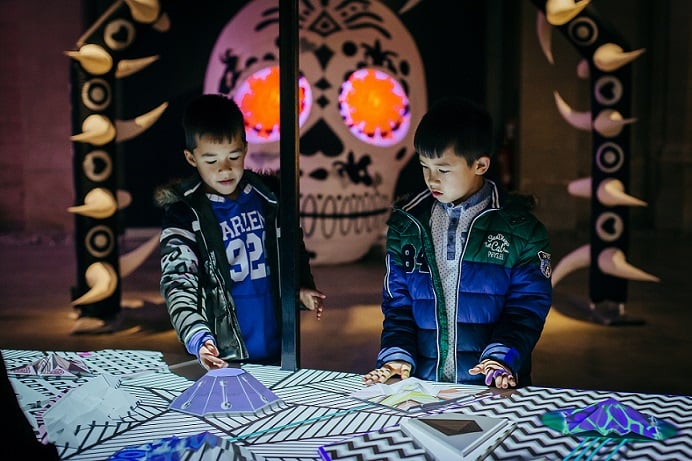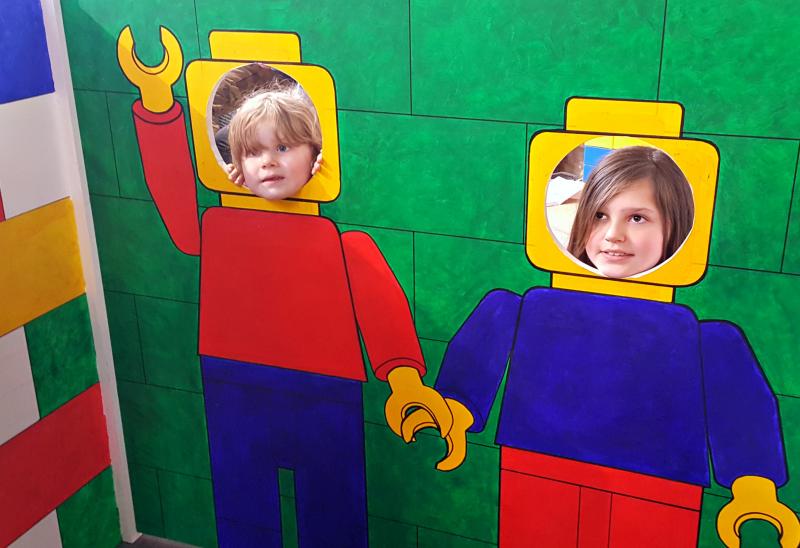
Children intruiged by the AniMotion exhibit at 2021
Photo: James Mulkeen
How to… attract family audiences
Don’t be afraid of fun, catch them early and remember that everyone loves LEGO – Michelle Lally shares her tips for engaging young people and families in the arts.
20-21 Visual Arts Centre, based in Scunthorpe, North Lincolnshire, has gained a national reputation for family-friendly events since its opening in 2001.
Here are some of our key tips for attracting children and families to your arts centre.
Jump on board national events
National events – including Museums at Night and The Big Draw – often have their own themes, but leave room to fit around your current programme and exhibitions. Organisers often offer advice and free toolkits for audience development, and wider marketing opportunities for your events and other support. Their listings and websites are also a good opportunity to see what other venues are doing.
Such events also give you a chance to experiment. For 2015 Museums at Night, artist Jessica Voorsanger led a parade of Men in Black agents, played by students of a local dance school, down the High Street to our gallery, followed by an evening of sci-fi themed activities in the gallery. It had a Pied Piper effect with shoppers and families following the parade to the centre for the event.
Talk to young people – even if you are in your twenties you’re already ‘old’ and ‘out of touch’
Involve artists
Sometimes people feel like artists are aloof, almost mystical beings. Using the right artists in events can really inspire children.
Think outside the box with the type of artists you can employ. Comic artists, animators, milliners, storytellers, film artists and graffiti artists can open up new possibilities and lead to a greater appreciation of the work and roles of creatives. Look to other art forms as well – local dance, music and drama groups can bring something extra to a static exhibition. Or why not bring in scientists, mathematicians or footballers.
Make things affordable
Affordability will be a key consideration in many locations, both for the audience and the organisation.
20-21 is located in an area of low arts provision that scores highly on the national index of multiple deprivation. As a venue that receives public funding we have a duty to work with and encourage children from areas considered hard to reach.
We offer free ‘artivities’ in the gallery each day and encourage all ages to take part. The materials are very low cost, often recycled or from a scrap store, offering excellent value for money and giving us a wide range of materials to work with.
We encourage donations and find that if you give people a quality experience they don’t mind chucking you a few coins if they can.

Know your audience
Talk to young people. It’s a bitter pill to swallow, but even if you are in your twenties you’re already old and out of touch. Our objective is to find out what’s popular now and stay relevant to families as children grow up.
Our current exhibition, Brick City, features LEGO and kids (of all ages) love it. It’s used in schools to teach numeracy and literacy, there are free apps that enable anybody to create films, comics and feedback using the ubiquitous bricks in many ways. Its descendants, sandbox games like Minecraft, can be equally versatile and work especially well with tech savvy kids.
Work with schools
Get in there. Assemblies can provide a forum to engage with pupils and most schools welcome contributions.
In North Lincolnshire several cultural venues contribute to a ‘School’s Out’ flyer, highlighting what there is to do in the area during school holidays, and this is delivered directly to the schools.
It’s also important to partner with other local organisations, services or venues that work with children and families.
Target the parents
On social media, Facebook in particular, most towns have pages called ‘Cheap things for kids to do in…’ where you can promote your events.
Don’t forget face-to-face contact in the wild and word of mouth – put posters in community centres, chip shops and taxi ranks.
Try other low-cost outreach, like putting a temporary market stall on the High Street. You’ll be surprised by how many people in your town don’t know what you offer beyond your front doors or even that you exist.

Catch them early
Our Stick ‘n’ Splodge creative, colourful and messy play sessions for under 5s have taken place weekly for many years and offer activities linked to our exhibitions. Participants continue to visit with their parents as they get older.
In the early days of the centre we ran a project called Hooked for the young people who used to hang around in the square outside the gallery. Now, as some of these teens have become parents themselves, they visit with their own children.
Don’t be afraid of fun
You’ll be surprised by how many people in your town don’t know what you offer beyond your front doors or even that you exist
Why so serious? Art can be fun as well as serious, political, challenging, insular, thought provoking, beautiful, relaxing, ugly, scary, and humorous – whatever we want it to be.
Our Art + Play exhibition offered commissions to artists to create work designed to inspire and appeal to pre-school children and their grown-ups through learning and play. The Pirates, Pant and Wellyphants exhibition looked at the work of illustrator and author Nick Sharratt. On the opening day the artist was mobbed by adoring fans and the exhibition contained many funny and interactive experiences for families to enjoy. Our AniMotion exhibition explored how contemporary artists use digital techniques including VR to create their work.
Drive creativity and imagination
Our exhibitions and the artists’ work is the basis for our work with children. It’s a catalyst for communication and we hope that we create gallery-going habits from the earliest age. Importantly, most of our exhibitions are not specifically for children and the interpretation, activities and events aim to provide an opportunity for a wide variety of art experiences for a range of ages and tastes.
Of course, all of this is irrelevant if you cannot provide a genuine, welcoming and accessible environment. Drive creativity and imagination, support those who need a bit of encouragement (this can be the adults as much as the children) and they will return and tell others.
Michelle Lally is Visual Arts Officer at 20-21 Visual Arts Centre.
www.2021visualartscentre.co.uk
[email protected]
Tw @2021VisualArts
Join the Discussion
You must be logged in to post a comment.